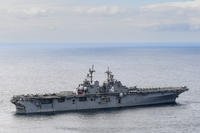Outgoing Pentagon acquisition czar John Young sharply criticized the Air Force today in his last meeting with reporters, saying the service had refused to budget for auto-landing gear for Predator UAVs even though the Air Force has lost a substantial portion of these to landing accidents. The new undersecretary of defense for acquisition, technology and logistics, Ash Carter, was sworn in this afternoon.
Young said the Air Force has lost one-third of the 183 Predators it has bought, and one third of those have crashed because of ground control issues. (Young's spokesman, Chris Isleib, later sent an email to reporters slightly changing the numbers. "Since 1994 the Air Force has procured 195 Predators. 65 have been lost due to Class A mishaps," he said.) Isleib added that of the 65 mishaps, 36 percent are laid at the door of human error and "many of those attributable to ground station problems." About 15 percent of the total was destroyed during the landing phase, Isleib clarified in his email. (For a very human and honest portrayal of the difficulties of flying a Predator, catch this briefing by a NASA pilot who has flown them.)
Young said he told the Air Force to "move as fast as possible to auto-land." A clearly irritated undersecretary of defense for acquisition, technology and logistics told reporters "it will not surprise you that the Air Force is resisting this." No cost estimates are available yet for equipping the Predator fleet with auto-land.
Young drew a sharp contrast with the Army's Shadow UAV, saying it had lost very few aircraft to landing mishaps because it possesses auto-land capability.
Isleib said in his email that they did “not have similar [crash] data for Shadow. However, we feel that improvements to the ground stations and addition of auto-land capability could reduce the overall mishap rate for Predator by 25 percent.”
Young also criticized the Army and the Air Force for simply not communicating. Although the Predator and Warrior [used by the Army] systems share a great deal in common, the two services have resisted sharing information about new engines and items such as signals intelligence sensors. Young, almost growling, said, “that’s power of OSD” to bring the services together in the same room and make them talk.
Young told reporters he regrets not pushing sooner to segregate various parts of the Army's Future Combat Systems program by issuing separate contracts for its vehicles, unmanned platforms and other systems.
The contract was heavily weighted so that Boeing and SAIC would receive 90 percent of their award fees based on performance before the program reached its Critical Design Review, leaving the Army with few tools to force better performance out of the program. Most award fees should be based, he said, on performance after CDR to ensure companies remain vigilant about performance.
Young also spoke at length about the acquisition enterprise but I’ll write about that in another post after talking with some acquisition experts to lend some perspective to Young’s remarks.








